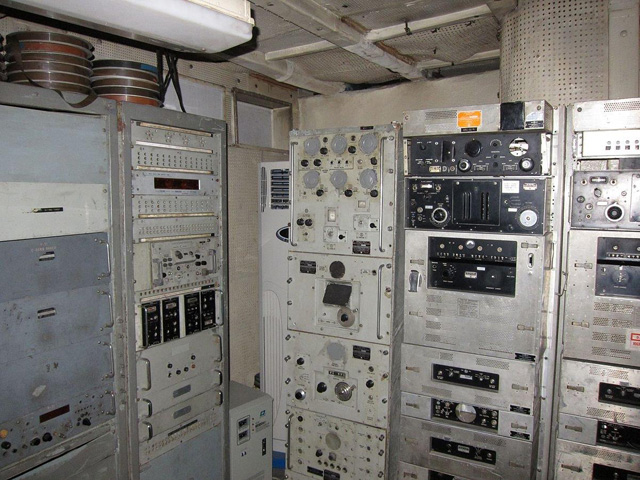SUGGESTED READING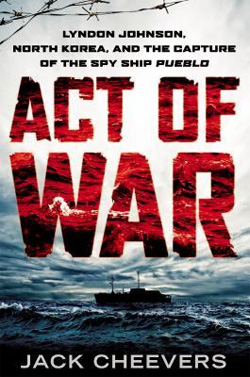
Act of War: Lyndon Johnson, North Korea, and the Capture of the Spy Ship Pueblo
RELATED POSTINGSHow Do You Solve A Problem Like Korea? National Security Agency Releases History of Cold War Intelligence Activities The National Security Agency Declassified
RELATED LINKOfficial Website of the USS Pueblo
|
Washington, DC, January 23, 2014 – Forty-six years ago today - well before Edward Snowden was born - the National Security Agency suffered what may still rank as the most significant compromise ever of its code secrets when the American spy ship USS Pueblo was captured by communist forces off the coast of North Korea on January 23, 1968. The U.S. Navy signals intelligence ship was on a mission to intercept radio and electronic transmissions, and apparently sailing in international waters, when North Korean naval units opened fire, then boarded the vessel and took its crew hostage for almost a year, sparking a major international crisis. Beyond the dramatic political ramifications of the seizure and hostage-taking for the Lyndon Johnson administration and U.S. world standing, the incident resulted in the capture of a dozen top secret encryption devices, maintenance manuals, and other code materials. Because it involved actual encryption equipment rather than just papers and briefing materials, the Pueblo affair may have produced a much greater loss than the recent disclosures of former NSA contract employee Edward Snowden. Recently declassified documents posted today by the National Security Archive describe tense U.S. internal reactions to the Pueblo seizure, and include previously withheld high-level political and military deliberations over how to respond to the episode in an atmosphere fraught with the dangers of a superpower conflict. Military contingency plans, which President Lyndon Johnson eventually rejected, included a naval blockade, major air strikes and even use of nuclear weapons against North Korea. Among the main disclosures in these documents, obtained through the Freedom of Information Act and archival research, are the following:
* * * *Spy Ship Pueblo:Dilemmas of Response in an International CrisisLyndon B. Johnson in January 1968Edited by John Prados and Jack Cheevers
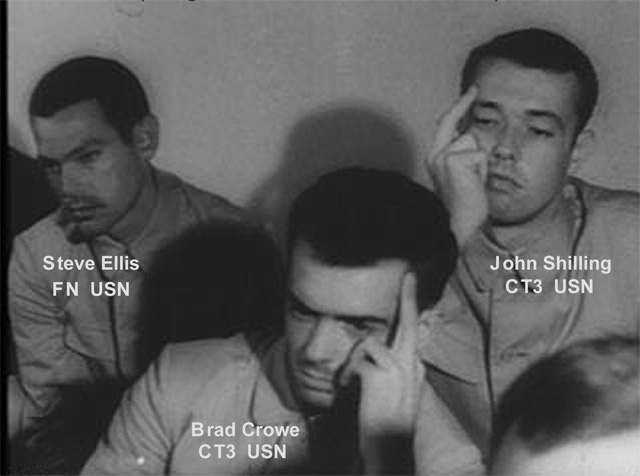 Captured USS Pueblo crew members display their middle fingers in an official DPRK photo. The "Hawaiian Good Luck sign" became a routine gesture of defiance whenever they were photographed. (Photo courtesy USSPueblo.org) Today, when many consider the actions of the leader of the Democratic Republic of North Korea (DPRK), Kim Jong-un, to be unfathomable and disturbing, there is a parallel to be made with those of his grandfather, Kim Il Sung. Forty-six years ago North Korean navy gunboats attacked and seized the U.S.S. Pueblo in international waters off the east coast of Korea. The Pueblo, a specialized U.S. Navy intelligence collection ship, was alone and virtually unarmed. The Pueblo was engaged in a mission to record communications and electronic emissions from North Korea. The ship had little recourse but to surrender when confronted by the North Korean warships. President Lyndon Baines Johnson considered but rejected various possible U.S. responses. Captured and taken to Wonsan, the Pueblo crewmen were imprisoned and tortured for months before Kim Il Sung freed them. The United States Navy and the National Security Agency (NSA) had long conducted an electronic intelligence interception program using naval vessels. The Gulf of Tonkin incident of 1964, and the Liberty incident in 1967 are both examples of international crises that had resulted from previous intelligence missions. Some of these missions were conducted by warships outfitted with extra equipment, others utilized specialized intelligence collection vessels. These missions typically aimed at obtaining knowledge about Soviet, Chinese, North Korean, or North Vietnamese technology-based military forces. By early 1968 this system for technical collection had become well-established. The Pueblo's cruise involved both Navy and NSA goals. The latter agency, interested in additional data on North Korean coastal defenses, first requested the coverage. And intercepts of message traffic were always useful in breaking codes. The Navy wanted intelligence on North Korean submarines and a new class of Soviet ones thought to be operating in the area.[1] The American naval commander in Japan, Rear Admiral Frank L. Johnson, had formal responsibility for the enterprise along with the task of evaluating the risks involved. Admiral Johnson assessed the Pueblo mission as involving little risk. Every higher level of command, up to the 303 Committee, President Johnson's National Security Council unit charged with controlling spy programs, joined in this low risk estimate. These assessments were made despite the fact that North Korean warships had sunk a South Korean patrol craft during 1967, and that the North Korean press had been making accusations regarding "spy boats" in DPRK waters.[2] It was LBJ's policy, particularly after the Liberty Incident, to approve only those missions evaluated as involving minimum risks. Had the assessments been different the Pueblo probably would not have been sent out. There were many flaws in the U.S. preparations for this spy mission (Document 9). On January 21, 1968, with the Pueblo already cruising in the Sea of Japan off the DPRK coast, North Korean commandos who had infiltrated across the Demilitarized Zone attempted to attack the official residence of the president of South Korea (Document 6). In his detailed study of the ship's voyage and its aftermath, co-author Jack Cheevers has found no evidence that the U.S. command informed the Pueblo of this event, which was certainly relevant to the question of the risks she might encounter.[3] This was in spite of the fact that American authorities routinely kept the ship informed of a wide variety of communist military activities throughout the Far East-the Pueblo received as many as 8,000 messages of this kind during its mission (Document 24). That same day a North Korean submarine chaser sailed close by Commander Bucher's ship, though without showing any hostile intent. On January 22, with the Pueblo off Wonsan, a pair of DPRK fishing trawlers circled her at a distance of less than 500 yards, then observed the American vessel from farther away, and finally closed back in to ball-tossing distance. Commander Bucher feared the DPRK ships might actually ram him. But the trawlers left the scene. Pueblo was not again approached until around mid-day on January 23, when a North Korean submarine chaser followed by three torpedo boats closed on her and ordered Bucher's ship to heave to. The American skipper turned his vessel toward the open sea but thePueblo, a slow ship, had no chance of outrunning her pursuers and the North Korean warships opened fire with cannon and machineguns. The Pueblo was captured, taken to Wonsan, and Commander Bucher and his crewmen began 335 days in captivity. North Korea claimed the U.S. ship had violated its territorial waters (Document 1). With her capture the NSA lost a host of cryptographic materials and encryption machines, plus whatever intercepted traffic the Americans had been unable to destroy. The crew's efforts to demolish these items were ineffective, in large part because the Pueblo's equipment for destroying classified materials was inadequate. A few days after the seizure a North Korean aircraft flew to Moscow with a load of almost 800 pounds, which officials speculated might be items gathered from the intelligence ship.[4] The NSA's damage assessment from the Pueblo affair nevertheless took the sanguine view that the Soviets would not be able to make use of the machinery because they lacked the necessary encryption keys (Document 25), not realizing in 1968 that the Russians were acquiring precisely this material from the Walker spy ring. 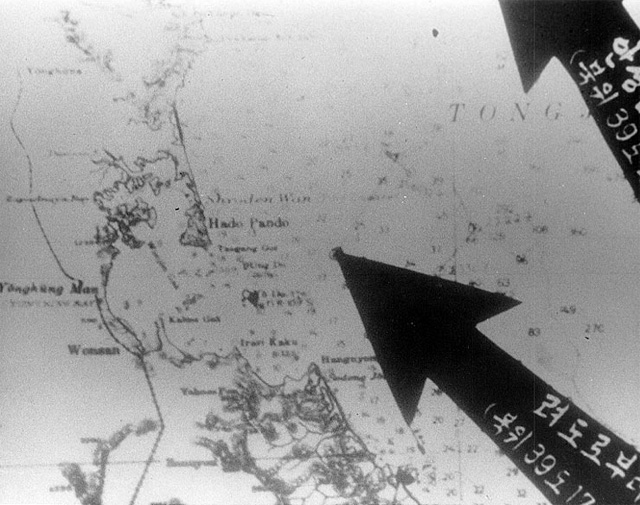 North Korean chart purporting to show the USS Pueblo had entered DPRK territorial waters off Wonsan. (Photo courtesy U.S. Naval Historical Center) Once the Pueblo had been captured, the Johnson administration faced acute dilemmas on how to respond. American forces in Japan proved unable to support the Pueblo when she needed help.[5] A detailed State Department chronology of the affair (Document 23) shows the intense efforts made to craft a policy. Although the Joint Chiefs of Staff, and senior U.S. commanders in South Korea prepared a series of military options (Documents 4, 6, 8, 13, 17), forces were not in place to carry them out. The U.S. Pacific Command ordered a buildup and a show of force in the Sea of Japan, Operation "Formation Star," but it would be ten days before means were in place.[6] At a series of meetings with senior advisers on January 24 and 25, President Johnson refused to be drawn in by imputations from national security adviser Walt Rostow and CIA director Richard Helms that Moscow was really behind the North Korean action.[7] He also expressed doubts regarding the potential military options (Document 2). The Soviet Union in fact proved somewhat helpful in the diplomatic measures that finally led to the release of the Pueblo's crew in December 1968 (Documents 11, 19, 23). As it conducted protracted negotiations with North Korea at Panmunjom, Washington was caught between pressures exerted by both South and North Korea (Documents 5, 10, 14, 20, 22, 23). President Johnson approved additional military aid for South Korea (Document 16). U.S. intelligence made fresh evaluations of tensions on the Korean Peninsula (Documents 12, 18). And the Pentagon, taking its cue from what had happened to the Pueblo, considered military support for future spy missions (Document 15). Congress, highly critical of the affair, conducted extensive hearings on the Pueblo Incident.[8] North Korea never returned the intelligence ship itself and in 2013 turned it into a floating museum in Pyongyang.[9] The documents in this briefing book have been collected by Jack Cheevers during his research for Act of War. They will form parts of a much more extensive donation to the National Security Archive. We will post a notice when the Cheevers collection is available for research.
THE DOCUMENTSDocument 1: Memorandum for the Chairman, Joint Chiefs of Staff: "PUEBLO Incident," January 24, 1968. Secret. Source: National Archives, Records Group 218, Records of the U.S. Joint Chiefs of Staff, Records of Chairman (Gen.) Earle G. Wheeler, 1964-1970, box 29, tab 439. After attacking and capturing the USS Pueblo, North Korea immediately claimed the spy ship had intruded into its territorial waters. The United States claimed that the ship had been operating on the high seas when it was seized. At the time, North Korea, like many communist nations, claimed a 12-mile territorial limit; the United States claimed only three miles. This cable, drafted early in the crisis, indicates that the American vessel was 17 miles offshore when it was first harassed by North Korean gunboats, and 23 miles offshore when captured.
 North Korean photograph, allegedly of USS Peublo's navigation records, January 1968. (Photo courtesy U.S. Naval Historical Center) Document 2: Cable, General Wheeler-Admiral Sharp, January 25, 1968. Top Secret. Source: National Archives, Records Group 218, Records of the U.S. Joint Chiefs of Staff, Records of Chairman (Gen.) Earle G. Wheeler, 1964-1970, box 29. This 4-page message from General Earle Wheeler, chairman of the Joint Chiefs of Staff, to Admiral Ulysses S. Grant Sharp, commander in chief of all U.S. forces in the Pacific, notified Sharp that President Johnson had opted to use diplomatic rather than military action to get back the Pueblo and its crew. Wheeler told Sharp to refrain from creating obstacles to a diplomatic solution by "facing the North Koreans and the Soviets with an ultimatum or with military actions which could be construed as a prelude to an ultimatum." At the same time, Wheeler passed on details of the massive U.S. military buildup in and around South Korea.
Document 3: CIA Intelligence Information Cable: "Opinions of Two Former North Koreans on the Pueblo Incident," January 27, 1968. Confidential. Source: LBJ Library, National Security File, National Security Council Histories, "Pueblo Crisis 1968, Vol. 12, CIA documents, [1]," box 32. The two unnamed "former North Koreans" gave remarkably prescient replies when asked what the Pyongyang regime would do with the Pueblo captives and how the U.S. should negotiate for their release. One source said the ship's capture was "politically motivated" and would be "exploited for propaganda value both at home and abroad." The American crewmen eventually would be sent home, since North Korea feared U.S. retaliation, but they might first be forced to admit that their ship intruded into North Korean waters. Both sources also said Pyongyang would not negotiate with the United Nations over the crewmen's release. It would, however, consider talks with the United States at the village of Panmunjom, where the U.S. and North Korea had negotiated over two U.S. Army helicopter pilots captured in 1963. A few days later, a U.S. admiral, John Victor Smith, opened a series of secret discussions with a North Korean general at Panmunjom.
Document 4: "Index of Possible Actions." Undated. Top Secret. Source: National Archives, Records Group, Records of Gen. Earle Wheeler, Chairman, JCS, box 29, tab 449. This 35-page document lists options for different types of military action against North Korea, and weighs the pros and cons of 12 possible U.S. responses to the Pueblo crisis. Most of them involved military force. The suggestions ranged from the relatively peaceful, such as sending a Navy tugboat to Wonsan harbor to retrieve the spy ship, to major actions likely to provoke a sharp response from North Korea, such as a "raid" by American tanks and troops across the Demilitarized Zone into communist territory or air attacks on seven training centers for communist commandos. Advantages and disadvantages of each option are described in blunt language by the unnamed author. LBJ ultimately chose Action No. 4 - "Show of Force" - ordering a large and rapid buildup of U.S. air and sea forces in and near South Korea. These forces consisted of 361 U.S. combat aircraft as well as an armada of 25 warships built around the USS Enterprise and two other aircraft carriers. The final option on the list was leaking "'firm' information" to the Soviets that the U.S. planned to attack North Korea in retaliation for the spy ship's capture.
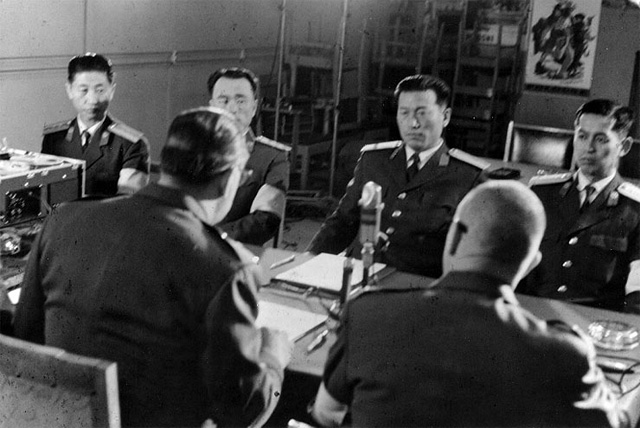 U.S. & North Korean representatives sign agreement for release of USS Pueblo crew. (Photo courtesy U.S. Navy) Document 5: Department of Defense cable, January 27, 1968. Secret. Source: National Archives, Records Group 526, "Pueblo," box 13, tab 28, folder US6500, USS Pueblo, January 26-27, 1968. In the jittery days after the capture, U.S. Army General Charles Bonesteel, the eyepatch-wearing former Rhodes Scholar who commanded United Nations forces in South Korea, met with the South Korean Joint Chiefs of Staff. The South Korean generals gave Bonesteel an earful. While expressing "great faith and trust" in the United States, Seoul's military men were deeply worried that Washington was more concerned about getting the Pueblo sailors back than it was with stopping North Korean guerillas who were slipping south to kill soldiers and civilians alike. They also demanded that the U.S. take "clear, punitive action to teach Kim Il Sung a lesson" and that promised U.S. counter-guerilla equipment be immediately airlifted to South Korean forces.
Document 6: CIA/DIA/State Memorandum, "Reactions to Certain US Actions," January 28, 1968. Secret. Source: Central Intelligence Agency release under FOIA. This 13-page interagency intelligence memorandum describes the Pueblo seizure plus the attempt by North Korean commandos just two days earlier to assassinate South Korean President Park as "the most flagrant and conspicuous manifestation" since 1966 of Kim Il Sung's long-running campaign to subvert and ultimately take over the south. At a time when President Johnson's advisers were deeply concerned that the Soviets may have had a hand in the attack on the spy ship, the report asserts that the North Koreans "apparently acted independently." It says there is "a fair chance" that the crew and possibly the ship can be recovered through "some combination of demonstrative actions, diplomacy, and a force buildup." The unnamed author goes on to list a number of retaliatory actions that could be taken, including mining Wonsan harbor (where the Pueblo was being held); air raids against military targets in the north; and an assault by a battalion-sized allied ground force across the Demilitarized Zone. However, the report warns that if the U.S. undertakes military action, the chances for an early release of crew "would be virtually eliminated." The use of force, the memorandum predicts, "would probably bring the Chinese and Soviets more directly into the situation."
Document 7: Central Intelligence Agency, "A Psychological and Political Analysis of Commander Bucher's Statements," January 29, 1968. Secret. Source: LBJ Library, National Security File, National Security Council Histories, Pueblo Crisis 1968, Volume 4, Day-to-Day Documents, Part 5, box 28. The unredacted portions of this 12-page document show that CIA analysts reviewed Bucher's service and medical records amid an intensive background investigation, ordered by LBJ, of whether the Pueblo skipper might be a traitor. The main conclusion was that Bucher was a loyal American, although he had a "strong inclination to become too involved with his men." The Agency profilers also speculated that Bucher had signed a forced "confession" in North Korea because he did not understand its significance as propaganda - a conclusion that defied credibility given Bucher's intelligence. He wrote clarifying comments in the margins after being shown a declassified copy of the document 35 years later.
Document 8: Central Intelligence Agency, Intelligence Report, "Merchant Shipping in North Korean Ports and En Route," January 28, 1968. Top Secret. Source: LBJ Library, National Security File, National Security Council Histories, Pueblo Crisis 1968, Volume 4, Day-to-Day Documents, Part 5, box 28. As the White House groped for a peaceful solution to the crisis, other arms of government were developing various military options, in case LBJ ultimately decided that force was necessary. One possibility was a "reciprocal" seizure of a North Korean vessel that could then be traded for the Pueblo. This CIA document lists the locations of North Korean-flag fishing vessels in late January 1968. It also notes foreign vessels then anchored in North Korean ports. Such ships could be affected if LBJ chose another military option, a naval blockade of North Korea.
Document 9: Pueblo Committee Report to President, Sixth Draft, February 7, 1968. Top Secret. Source: LBJ Library, National Security File, Intelligence File, Pueblo (January 1968), box 11, document 2. Early on in the crisis, President Johnson asked international lawyer George Ball to get to the bottom of the Pueblo incident and report his findings to Congress. Ball, who had formerly served as LBJ's undersecretary of state, formed a small committee whose members included General Mark Clark, commander of all U.N. troops in the Korean War, and Admiral George Anderson, who had been in charge of the U.S. Navy blockade of Cuba during the missile crisis. Johnson hoped the Ball Committee's findings could be used to head off any embarrassing congressional hearings, and he had pledged to make them available on Capitol Hill. But the blunt criticisms of the planning of the Pueblo mission in this 16-page draft report evidently never were presented to Congress.
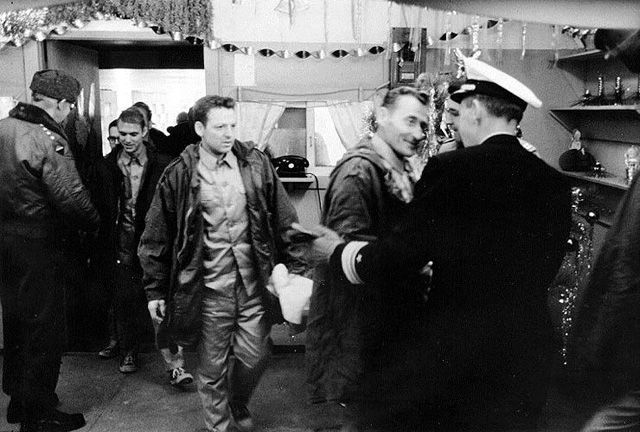 General Charles H. Bonesteel III, U.S. Army, Commander-in-Chief, United Nations Command, (left) and Rear Admiral Edwin M. Rosenberg, USN, Commander Task Force 76, (right) greet members of Pueblo's crew in the Korean Demilitarized Zone, after their release on 23 December 1968. (Photo courtesy U.S. Navy) Document 10: Central Intelligence Agency Weekly Review, February 16, 1968. Top Secret. Source: Central Intelligence Agency release under FOIA. This report indicates that during the 20th anniversary celebrations of the founding of the (North) Korean People's Army, premier Kim Il Sung accused the Pueblo sailors of a "gangster-like, piratical act" that proved "U.S. maneuverings" for a new Korean war had reached a "grave stage." It also notes that the Soviets have dispatched 15 warships to the Sea of Japan, making a show of force in the wake of the arrival of an American battle group in the area. Although most of the Soviet vessels stayed north of the seaward extension of the 38th parallel, a few have moved south and are trailing U.S. ships.
Document 11: State Department, Embassy Moscow Cable 2853, "Kosygin on Korea," February 20, 1968. Confidential. Source: LBJ Library, National Security File, National Security Council Histories, Pueblo Crisis 1968, Vol. 20, box 37, tabs 3-5. In this 2-page cable, the U.S. embassy in Moscow reports on a speech by Soviet premier Aleksey Kosygin in which he stated that the Soviet government is "taking necessary steps [to] prevent Korea from becoming [a] hotbed of war." The cable may have reduced fears in Washington that the Soviets had a role in the capture, possibly even orchestrating it. While Ambassador Llewellyn E. Thompson notes that Kosygin's speech is open to interpretation, he cables that it "supports previous indications" that Moscow is "trying [to] reduce temperature yet avoid irritating Pyongyang."
Document 12: Central Intelligence Agency, Report, "Memorandum to Holders of NIE 14.2-67: North Korean Intentions and Capabilities with Respect to South Korea," February 23, 1968. Secret. Source: LBJ Library, National Security File, Country File, Korea, Cables & Memos, Vol. 5, box 225. This report updates the current National Intelligence Estimate (NIE) on North Korea, surmising that the Pyongyang regime "probably believes" that the United States, preoccupied with the Vietnam War, will restrain South Korea from any retaliatory attacks and will not "escalate its own responses" to the Pueblo seizure. Although the communists probably see "great opportunities" to exploit current tensions between Washington and Seoul, the NIE update continues, Kim Il Sung does not plan to invade South Korea and probably will not aggravate the situation to the point that war breaks out. However, the memo warns, "the general situation in Korea is more dangerous than it was last fall, since the possibilities of miscalculation are greater." Pyongyang's attempt to murder President Park indicates that it is willing to "run fairly high risks," including "major retaliation" by Seoul.
Document 13: Cable, Commander in Chief, Pacific Forces to Joint Chiefs of Staff, February 25, 1968. Top Secret. Source: LBJ Library, National Security File, National Security Histories, Pueblo Crisis, Vol. 7, Day-to-Day Documents, Part 13, box 30. While the State Department conducted secret talks with the North Koreans aimed at settling the crisis peacefully, the Pentagon laid plans for dealing with contingencies that included a possible pre-emptive strike by the north against South Korea. This partially redacted document outlines a plan by Admiral Ulysses S. Grant Sharp, commander of all U.S. forces in the Pacific, in which American and South Korean warplanes would try to destroy the entire North Korean air force. Waves of American tactical fighters and B-52 bombers, joined by South Korean jets, would attack the "most lucrative" communist bases around the clock until the skies were free enough of northern jets to permit allied ground combat operations. The U.S. planning also included a nuclear option. (See Document No. 17)
Document 14: Embassy Seoul Cable 4596, February 29, 1968. Secret. Source: LBJ Library, National Security File, Country File, Korea - Pueblo Incident, Seoul cables, Vol. 2, 2/11/68 - 3/68, box 262. With tensions still high and the Panmunjom talks dragging on inconclusively as the crisis passed its one-month mark, the South Korean government nervously sought assurances that the United States would help protect it against possible communist attack. In this cable U.S. Ambassador William Porter describes a meeting with the South Korean foreign minister, Choi Kyu-hwa. With South Korean newspaper reporters waiting outside his office, Choi engages in a diplomatic minuet with Porter, demanding more iron-clad defense guarantees from Washington. But Porter deflects Choi.
Document 15: Department of Defense, Memorandum for the Deputy Secretary of Defense, "USS Pueblo Incident," March 29, 1968. Top Secret. Source: National Archives, Records Group 218, Records of the U.S. Joint Chiefs of Staff, Records of Chairman (Gen.) Earle G. Wheeler, 1964-1970, box 29, tab 303. Following the Pueblo seizure, Deputy Defense Secretary Paul Nitze asked General Wheeler a series of pointed questions. Among them: Had the military done anything after the National Security Agency warned that it might want to consider air or sea protection for the spy ship? Wheeler conceded that "appropriate external support will have to be provided for future [spy] operations in high risk areas." He also referred to the Pueblo as a "non-combatant" - an interesting word choice in light of the Navy's subsequent efforts to court-martial Commander Bucher for giving up the ship without a fight.
Document 16: State Department Circular Cable, Airgram A-521, "ROKG Strategic Intentions and the ROK April 5 MND Plan," April 16, 1968. Secret. Source: LBJ Library, National Security File, National Security Council Histories, Pueblo Crisis 1968, Vol. 21, Airgrams, Misc., box 37, document 171. As LBJ and Park Chung Hee prepared for a face-to-face meeting in Honolulu, the U.S. embassy in Seoul delivered its analysis of a recent South Korean Ministry of National Defense (MND) plan to sharply bolster the nation's military strength. The 18-page report, written by Deputy Chief of Mission George S. Newman, concluded that South Korean thinking on defense policy had undergone "a major shift" in the wake of North Korea's capture of the Pueblo and its attempt to kill Park. Newman wrote that the South Korean defense minister's recent proposal to substantially increase his country's ground, air, and naval combat capabilities would fundamentally alter South Korea's essentially defensive military posture, giving it powerful offensive punch. Newman recommended against full U.S. support of the plan, saying it "could lead to a military force capable of independently taking courses of action inimical to the U.S. national interest." His report noted that the South Koreans had been conducting secret retaliatory raids into northern territory without U.S. knowledge or approval, and that additional military strength could tempt Park and his generals to preemptively attack North Korea "in the belief that [they] could win a relatively short war."
Document 17: Memorandum for the Chairman, Joint Chiefs of Staff, "Possible Responses to North Korean Attack on the Republic of Korea," May 14, 1968. Top Secret. Source: National Archives, Records Group 218, Records of the U.S. Joint Chiefs of Staff, Records of Chairman (Gen.) Earle G. Wheeler, 1964-1970, box 29, folder Korea 091, 1 May 1968 - 31 April 1969. This 4-page document provides additional details on Admiral Sharp's contingency plans to defend South Korea against possible invasion by the north. It envisions the use of both conventional and nuclear weapons. In one scenario, codenamed "Fresh Storm," American tactical jets and B-52 bombers, possibly joined by South Korean aircraft, would conduct around-the-clock attacks intended to wipe out the entire North Korean air force. Under another plan, codenamed "Freedom Drop," U.S. combat jets and/or land-based Honest John and Sergeant rockets would rain nuclear explosives on attacking communist troops and tanks. Nuclear warheads with yields up to 70 kilotons could be used against a handful of military targets or "all significant North Korean offensive and logistic support targets."
Document 18: Central Intelligence Agency, Special National Intelligence Estimate 14.2-68, "The Likelihood of Major Hostilities in Korea," May 16, 1968. Secret. Source: LBJ Library, National Security File, National Security Council Histories, Pueblo Crisis 1968, Volume XI, Background Documents. After a few months of relative quiet, North Korean infiltrators and saboteurs in the spring of 1968 resumed their attacks in the Demilitarized Zone and Seoul. With the advent of better weather, communist guerilla teams were expected to begin slipping down both Korean coasts in a renewed effort to establish bases in the mountainous hinterlands. This 7-page report concluded that North Korea did not intend to invade the south or do anything else that risked escalation to full-scale war. Instead, the north was determined to create conditions for a guerilla-style "people's war" in South Korea. Through the use of terrorist attacks and political subversion, the north hoped eventually to destabilize South Korea's government and lay the groundwork for the reunification of the two Koreas under communist rule. However, the report warned, the "the principal danger" was that the north would miscalculate and push the south too hard, prompting "an increasingly exasperated" President Park to order "a large-scale retaliation" and setting off an equally serious counterattack by the north.
Document 19: Department of State, Memorandum of Conversation, "Korea," May 17, 1968. Secret. Source: National Archives, Records Group 59, General Records of the Department of State, Central Foreign Policy Files, 1967-1969, Political and Defense, Pol 33-6, Kor N-US, 5/1/68 - 7/1/68, box 2271, folder: 5/1/68. Despite the Soviets' earlier refusal to assist the United States in getting back the captured sailors, Secretary of State Dean Rusk again turned to Moscow as the crisis continued in May. Meeting in his private State Department dining room with Soviet Ambassador to the U.S. Anatoly Dobrynin and Deputy Foreign Minister Vasily Kuznetsov, Rusk warned that "the situation could become explosive" and asked for Soviet help "to keep things cool." He also threatened that the United States would react with "maximum violence"-presumably a reference to its willingness to use nuclear weapons-if North Korea attacked the south.
Document 20: "Alleged Sinking of 'Spy Boat' by North Koreans," KRA 1901, June 24, 1968. Secret. Source: National Archives, Records Group 218, Records of the U.S. Joint Chiefs of Staff, Records of Chairman (Gen.) Earle G. Wheeler, 1964-1970, box 29, folder: 091, Korea 5/1/68 - 4/31/69. On June 22, 1968, North Korea apparently attacked and sank a South Korean reconnaissance boat with a crew of 15. The mission had been launched without the knowledge or approval of U.S. Army General Charles Bonesteel, who, as commander in chief of United Nations forces in South Korea, ostensibly controlled South Korea's navy. In this cable Bonesteel describes how he criticized South Korean military officials for a covert action that "could not have been better planned, time[d] or executed to enable maximum exploitability [by] the North Koreans." Bonesteel also warned that the South Korean spy mission could jeopardize efforts to get the Pueblo sailors released.
Document 21: Central Intelligence Agency, "The Pueblo," DCI briefing for members of unnamed congressional defense appropriation committee, September 23, 1968. Secret. Source: LBJ Library, National Security File, National Security Council Histories, Pueblo Crisis, Vol. 8, Day-to-Day Documents, Part 16, box 30. As the Panmunjom talks dragged on without resolution in the fall of 1968, an unnamed CIA official told members of Congress that the captured sailors were being held at an airborne training school east of Pyongyang and that, "as far as we can judge, the crew has not been physically mistreated." In fact, the crewmen had been tortured, beaten, and subjected to near-starvation since their ship was captured in late January. The CIA official also revealed that the Pueblo had been moved from the Wonsan area to the port of Najin, near the Soviet border, and that the North Koreans had finished dismantling its antennae and had "probably… completed their exploitation of the ship's equipment."
Document 22: Central Intelligence Agency, Intelligence Information Cable, "Reactions of Pueblo Crew Members at Press Conference on 12 September," October 5, 1968. Secret. Source: National Archives, Document 54, released under mandatory declassification review with no other identifying details. On September 12, 1968, the North Koreans brought in dozens of journalists from around the world for a carefully managed "press conference" featuring Commander Bucher and other members of the Pueblo crew. This cable is based on conversations with at least one journalist who attended. The journalist noted that Bucher "seemed insincere" when he said the American sailors were guilty of espionage and that other crewmen who spoke at the event "seemed to be acting out a role and performing well."
Document 23: Department of State report, "Pueblo Crisis: Presidential Decisions and Supplementary Chronology," December 12, 1968. Top Secret. Source: LBJ Library, National Security File, National Security Council Histories, Pueblo Crisis, Vol. 1, Basic Study & Presidential Decisions, "re: USS Pueblo." Top secret. This 51-page document, prepared by the State Department's historical division, chronicles the efforts of President Johnson and his advisers to cope with the Pueblo debacle. It is an almost minute-by-minute account, lightly redacted and fairly dramatic. When news of the Pueblo first reached Washington around midnight on January 22, 1968, urgent phone calls flew among national security adviser Walt Rostow, Defense Secretary Robert McNamara, and Secretary of State Dean Rusk before Rostow finally woke up LBJ at 2:25 a.m. In a series of meetings over the next few days, Johnson and his men struggled to divine North Korea's intentions; restrain South Korea's angry and frightened president from attacking the north and starting a second Korean War; enlist an unlikely ally -- the Soviet Union -- in pressuring Pyongyang to give back the ship and its crew; and rapidly build up American military strength on and near the Korean peninsula, in case armed conflict broke out. One of LBJ's biggest problems was trying to control South Korean President Park Chung Hee, an ex-general who was strongly tempted to bomb or even invade the north after communist infiltrators nearly succeeded in assassinating him in Seoul just two days before the Pueblo seizure. The document vividly shows the stakes in this Cold War confrontation, as U.S. warships and air combat units are alerted to prepare for "forceful action."
Document 24: National Security Agency report, "Damage Assessment of the Compromise of Operational Intelligence Broadcast Messages On Board USS PUEBLO (AGER-2)," March 17, 1969. Top Secret. Source: NSA release under mandatory declassification review. Among the items captured aboard the Pueblo were "highly classified" messages radioed to the ship as part of the Navy's operational intelligence broadcasts originating from Guam. From January 5 to January 23, 1968, the ship received as many as 8,000 such messages. Assessing the potential damage to U.S. security interests, National Security Agency analysts described these messages as "extremely valuable to the Communists." The so-called GOPI broadcasts contained a wide variety of reports on U.S. electronic eavesdropping on communist ground forces, maritime activities, and air defenses throughout Southeast Asia. For instance, the reports revealed the ease with which U.S. eavesdroppers were collecting data on North Vietnamese combat aircraft and antiaircraft missile operations. Such knowledge, the report warned, might cause the communists to tighten their communication security and put attacking U.S. air crews at greater risk.
Document 25: National Security Agency, Cryptographic Damage Assessment, Section V, "USS PUEBLO, AGER-2, 23 January-23 December 1968," February 28, 1969. Top Secret. Source: NSA release under mandatory declassification review. When it departed from Japan, the Pueblo carried four different types of encryption machines: a KL-47 for offline encryption, two KW-7s for online encryption, three KWR-37s for receiving fleet-wide operational intelligence broadcasts, and four KG-14s, used in conjunction with the KWR-37s. According to this damage report, the crew's frantic efforts while under attack to destroy classified materials were "ineffective" and "a majority" of the code machines and their associated keying material and maintenance and operating manuals were compromised. However, the report says, since the communists lacked the key cards needed to operate the code machines, "the absolute threat to U.S. [secret] communications resulting from the loss of cryptographic equipment is minimal." What the NSA analysts did not know at the time was that the Soviets were secretly buying Navy codes and a wide variety of other classified documents from John Anthony Walker Jr., a Navy radio specialist turned traitor. Walker and several associates continued to steal and sell U.S. military secrets to Moscow for an astonishing 18 years, until the FBI finally arrested him.
NOTES[1] Mitchell B. Lerner, The Pueblo Incident: A Spy Ship and the Failure of American Foreign Policy. Lawrence: University Press of Kansas, 2002, p. 69. [2] Richard Mobley, "Pueblo: A Retrospective," Naval War College Review, Spring 2001, p. 101. [3] Jack Cheevers, Act of War: Lyndon Johnson, North Korea, and the Capture of the Spy Ship Pueblo. New York: NAL/Caliber Books, 2013, p. 58. [4] Mitchell Lerner, The Pueblo Incident, pp. 30-34, 83. [5] Ibid., pp. 93-95. [6] Richard Mobley, "Pueblo: A Retrospective," p. 99. [7] Jack Cheevers, Act of War, pp. 109-116. [8] United States Congress. House Armed Services Committee (91st Congress, 1st Session). Special Subcommittee on the U.S.S. Pueblo, Hearings/Report: Inquiry into the U.S.S. Pueblo and EC-121 Plane Incidents. Washington: Government Printing Office, 1969. Cf. Trevor Armbrister, A Matter of Accountability: The True Story of the Pueblo Affair. New York: Coward-McCann, 1970, passim. [9] Associated Press, "North Korea Changes on Return of USS Pueblo," Washington Post, November 14, 2002, p. A4; NBC News, "North Korea's Cold War Prize, USS Pueblo, set to be displayed for 'Victory Day'," July 26, 2013 (http://photoblog.nbcnews.com/_news/2013/07/26/19681227-north-koreas-cold-war-prize-uss-pueblo-set-to-be-displayed-for-victory-day?lite).
|
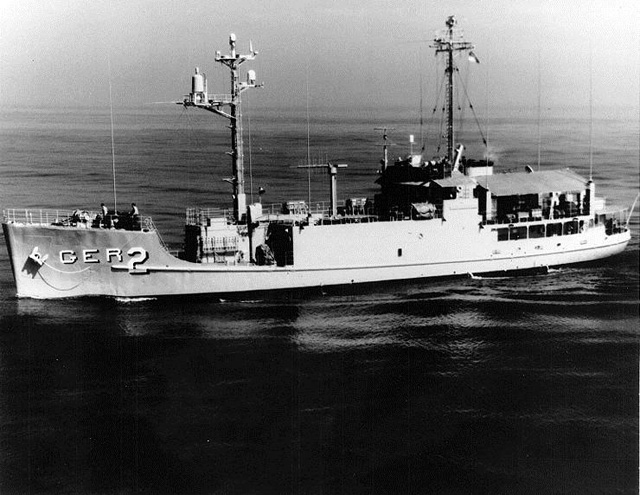 USS Pueblo (AGER-2) off San Diego, California, October 19, 1967. (Photo courtesy U.S. Navy) |
USS Pueblo: LBJ Considered Nuclear Weapons, Naval Blockade, Ground Attacks in Response to 1968 North Korean Seizure of Navy Vessel, Documents ShowNSA Initially Downplayed Potential Damage from Capture of Sensitive Encryption Equipment from Spy ShipDeclassified Documents Describe Tense Internal U.S. Deliberations and Contingency Planning in Wake of IncidentNational Security Archive Electronic Briefing Book No. 453Posted January 23, 2014 Edited by John Prados and Jack Cheevers For more information contact: |



